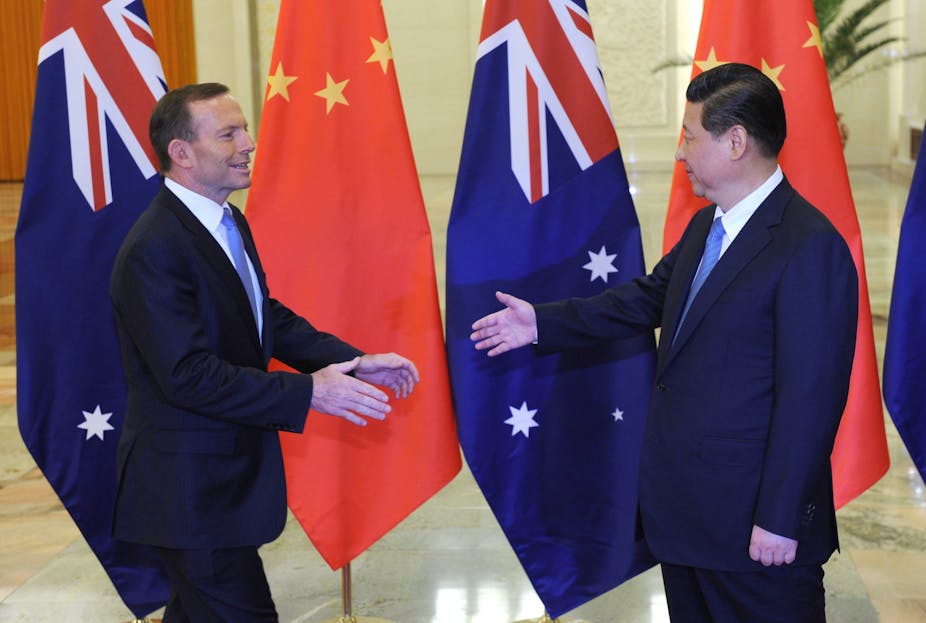This week treasurer Joe Hockey, and trade minister Andrew Robb have been in China for the inaugural Australia-China Strategic Economic Dialogue. These talks are one part of the “Strategic Partnership” agreed to between the two countries in 2013.
Leading up to the event, media releases emphasised that the Economic Dialogue would be used to convey the message that Australia was “open for business” and in particular, to expedite the long-running negotiations for a free trade agreement (FTA). Initial reports after the talks saw the Australian side express optimism that a trade deal could be reached by the end of the year.
This is consistent with Tony Abbott’s pre-election pledge to strive to secure three FTAs (Japan, Korea and China) within his first 12 months as prime minister. Some have complained that Abbott’s self-imposed deadline needlessly weakens Australia’s bargaining position. After all, if a deal cannot be reached, it will embarrass Abbott more than his Chinese counterpart.
There is however, a much bigger threat to Australia’s negotiating position. That is the external environment in which a conclusion to FTA negotiations is being sought is less favourable to Australia than at almost any other time since discussions began more than eight years ago.
As I and others have written previously, for an FTA to be worthwhile from an Australian perspective, significant concessions by China are needed in the areas of agriculture and services. Given fears in China over food security and the plight of farmers who tend to be at the lower end of the income distribution, the implication is that Australia would need to come to the party with significant concessions of its own. However, Australia’s trade barriers are already low almost uniformly across the board.
The single most important factor providing some hope that China might be willing to make significant concessions was the scope for Australia to liberalise rules surrounding foreign investment. As it currently stands, nearly all Chinese investment proposals irrespective of value require Foreign Investment Review Board approval, in contrast to the A$1.08 billion threshold applying to investment from the US and New Zealand, and that will soon be extended to Korea and Japan.
For much of the past decade China has shown enthusiasm for investing in Australia, and in particular, in the natural resources sector. However, changes in the external environment are now eroding such enthusiasm.
One motivation underpinning Chinese investment has been a hedging strategy. As the prices of commodities such as iron ore and coal skyrocketed on world markets, while China may have suffered as a customer, by developing greenfield projects and/or taking equity stakes in existing miners, at least it could profit as a shareholder.

However, output prices are no longer as high as they were, with the Reserve Bank of Australia’s Commodity Price Index down by more than 30% since 2011. Add in rising costs associated with project development and profit margins have been squeezed.
Chinese investment has also been motivated by a desire to achieve higher returns on its enormous stockpile of foreign exchange reserves than the traditional holdings of US Treasury bonds. While this was the expectation, the reality over time has proven quite different. Generally speaking, China’s experience of investing in Australia’s natural resources sector has not been a happy one. Numerous projects can be cited that have been funded in part or full by Chinese capital and that are now showing losses stretching into the billions.
There is also the possibility that Australian negotiators may have been able to hold up the prospect of eliminating tariffs on imports of Chinese cars, as had been done for Japan and Korea, and which currently stand at 5%. However, the demise of the domestic car manufacturing industry makes such an offer hollow. Irrespective of whatever trade deals are reached, the rationale for car tariffs has now disappeared.
It is perhaps not surprising then that according to data collated by Sydney University and KPMG, Chinese investment in Australia fell by 10% in 2013, in contrast to an overall global increase.
For its part, and perhaps responding to a wane in Chinese interest, the rhetoric of the Australian government has improved considerably. In 2012, responding to the possible non-commercial objectives of state-owned enterprises, Tony Abbott, then Leader of the Opposition, contended that “It would rarely be in Australia’s national interest to allow a foreign government or its agencies to control an Australian business”. In April this year however, he stated that he now understood that China’s state-owned enterprises these days are mostly highly commercial businesses, and just a few days ago, Joe Hockey stated that “We are open for business and that includes state-owned enterprises out of China”.
While this new tone will no doubt be welcomed by China, the above changes in the external environment mean that the bargaining chip of investment liberalisation is no longer as enticing as it once was. The conclusion is that while FTA negotiations may well be drawing to a close and an agreement of some sort soon signed, the prospect for a high quality Australia-China FTA remains as distant as ever.

